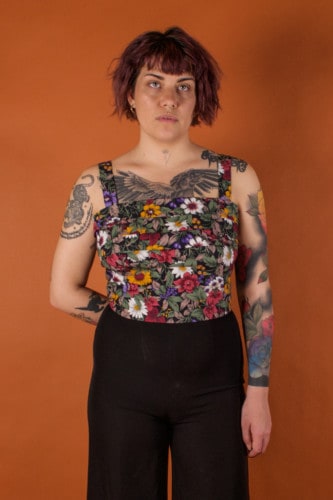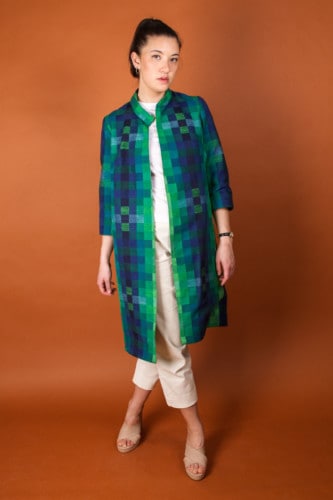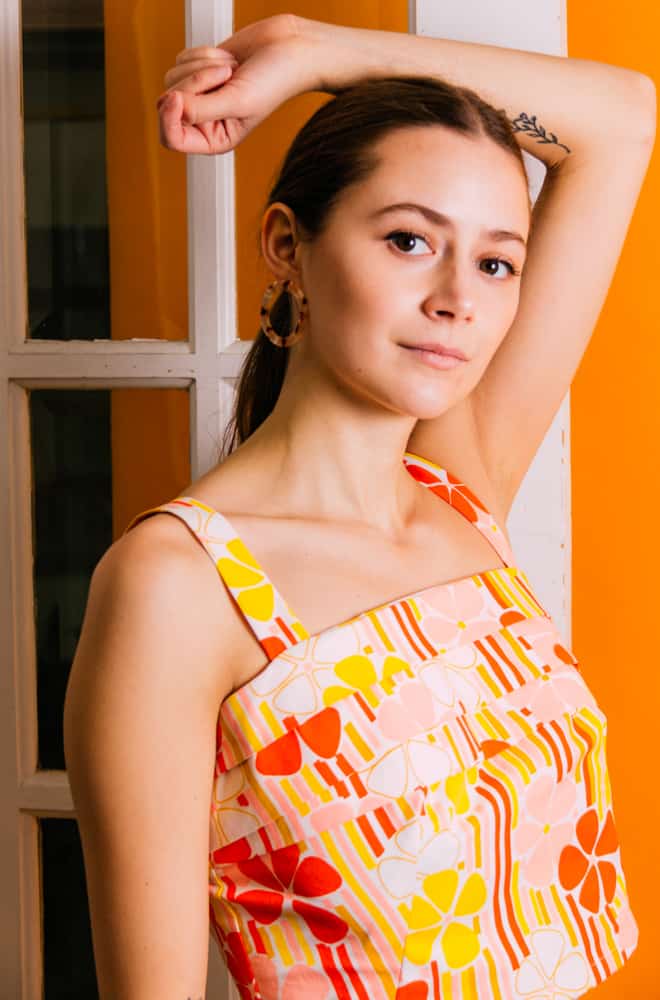Isla Cowan, the Toronto-based seller behind Etsy shop Heavy Flow, was recently nominated for an Etsy global design award for her Upcycled jacket (made from a vintage tablecloth). We are loving her one-of-a-kind garments, made by hand using vintage textiles.
We chatted with Cowan about her work this week.
SDTC: How did you get interested in fashion as a kid?
IC: My earliest memory of being into fashion and designing was when I was around 12 years old driving around Cape Breton with my mom, reading Archie comics. I used to draw out Betty and Veronica’s outfits with pencil crayons. That sixties aesthetic always stuck with me and has definitely influenced my current designs with Heavy Flow.
What was the first piece you remember sewing?
The first piece I ever sewed was a maxi skirt made from four camouflage bandanas. I think I was about nine years old and having a sleepover at my grandma’s. We used her old Singer for the first few seams until it broke; then we continued sewing the rest together by hand. Needless to say, the skirt didn’t stand the test of time.

Whose style do you most admire?
My friends’. Everyone brings something different to the table and isn’t afraid to take risks or wear what makes them feel confident and unique, even if it pushes the boundaries of “trends.”
How would you describe your personal style?
My style is contemporary Golden Girl meets Bart Simpson. I pretty much only wear sneakers after giving up on heels a couple of years ago. If I’m working in the studio, I try to wear clothes that are comfortable enough to be able to move around in and hop up on tables to cut when I’m out of reach of the fabric that I’m working with. I mix in a lot of vintage clothes as well. My collection is pretty close to being out of control.

What trends would you like to see die already? What looks are you loving lately?
If I’m being honest, I’m not really into following trends. I think they contribute to a culture of fast fashion with less thoughtful purchases. Of course, all fashion, including my own is influenced by trends, but it’s something I try to avoid following dogmatically.
I’ve been very into the look of sheer ruffles, sport shorts, and matching pant/top sets this summer. It’s a weird combination, but it’s a pretty accurate blend of things I like to wear together. I’m also working on releasing some co-ordinating sets of all three styles in the next round of pieces we are posting to our website.
What was it like being nominated for an Etsy?
Unexpected! I did not anticipate to be a finalist for this global competition, as Heavy Flow is such a new project. We only launched in February of 2019, so getting a nod from such an established community like Etsy this early in is incredible. After running a vintage store for four years on Etsy, and then getting recognition for something that I created with my own hands, is a pretty unbelievable feeling.
Walk us through the process of creating one of your pieces.
The very first step in the process of creating a Heavy Flow piece is sourcing the vintage fabric. I refer to the process as “treasure hunting,” as it is never one avenue of finding the materials to work with. I find textiles in many places like second-hand shops, estate sales, or from people with a surplus of unused material who do not want to see it end up in a landfill.
The next step is to determine what fabric works best for which style and to make sure that the fabric has enough yardage to become a garment. Seeing what style and/or size I can get out of a particular fabric is like a puzzle: I play around with pattern pieces to reduce waste and get the most out of the small cuts I have to work with. As each textile I work with is so different, I do my best to visualize the final result (how it will look, move and feel). I have to be very careful and intentional when cutting out the material. It’s a labour of love.
What do you love most about using vintage textiles in your pieces?
The aspect I love the most when working with vintage fabric is the sustainable practice of utilizing pre-existing materials and minimizing the demand for textile production. It’s a small impact overall but makes me feel good when I’m sewing. It’s also great to see customers get excited when they buy a piece that only they will have. Everything is one of a kind, and like vintage clothing, it tells a different story with each piece.




 Follow Us On Instagram
Follow Us On Instagram
